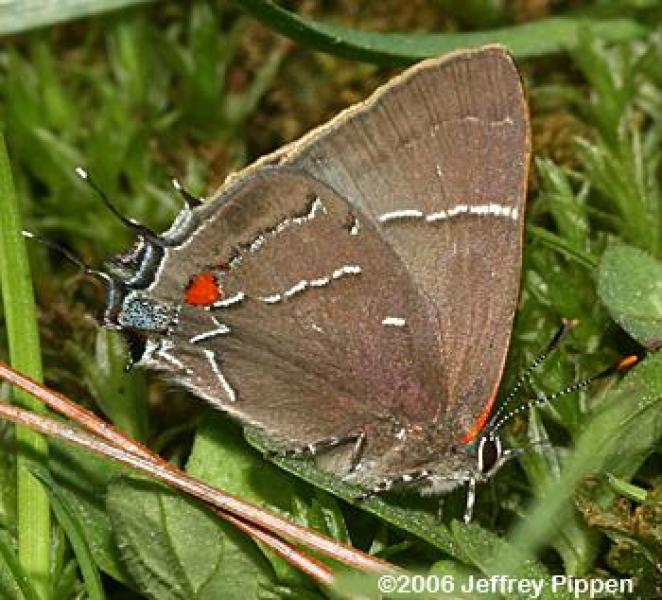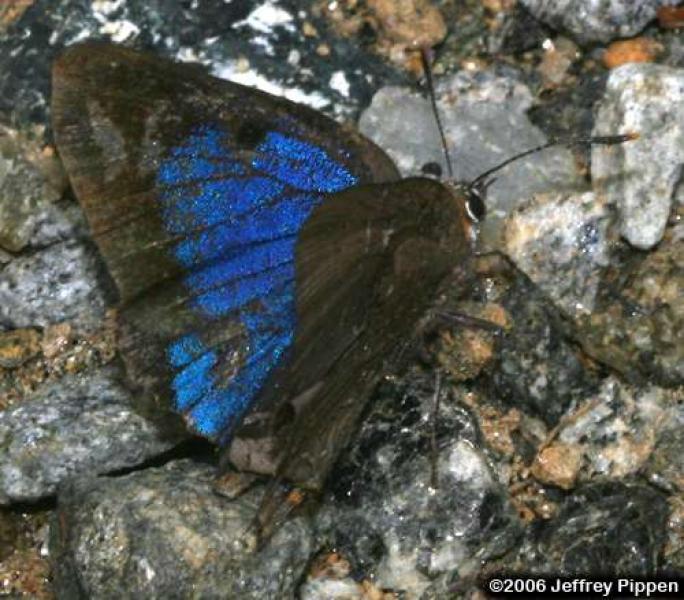White-m Hairstreak
Parrhasius m-album (Boisduval and Le Conte, [1833]) (1793)
- Class
- Insecta (Insects)
- Family
- Lycaenidae (Blues, Coppers, Hairstreaks, Elfins)
- State Protection
- Not Listed
Not listed or protected by New York State.
- Federal Protection
- Not Listed
- State Conservation Status Rank
- SU
Unrankable - Currently unrankable due to lack of information or due to substantially conflicting information about status or trends.
- Global Conservation Status Rank
- G5
Secure globally - Common in the world; widespread and abundant (but may be rare in some parts of its range).
Summary
Did you know?
The rarely seen metallic blue color on the dorsal surface of the wings is thought to play a role in sexual selection (Sourakov 2008).
State Ranking Justification
Although this species seems to have expanded its range, it nevertheless is always found in very low numbers and has been found at only a few locations confined to extreme southeastern New York. Population abundance is known to vary widely from year to year. Because it appears to be a generalist, occupying heavily urbanized areas and feeding on a variety of common food sources in both the adult and caterpillar stage, threats to the viability of populations are unclear at this time. It is not certain that this species will remain on the active tracking list in the future.
Short-term Trends
Only two records (Rockland and Richmond Counties) were reported by Shapiro (1974). Glassberg (1993) and Cech and Tudor (2005) felt that the species was expanding its range northward and by the mid 2000s the species was reported as far north as Putnam and Orange Counties (Fiore and Wallstrom 2003-2006). Matteson and Roberts (2010) reported upwards of 30 sightings of this species in the New York City metropolitan area between 2001 and 2009.
Long-term Trends
This species seems to have expanded its range northward in New York over the past four decades, possibly as a result of a longer flight season due to global warming (Glassberg 1993).
Conservation and Management
Threats
Because this species seems to be expanding in New York, threats are unclear. In general, urbanization, habitat loss and insecticide spraying can threaten butterfly populations in metropolitan New York City (Matteson and Roberts 2010).
Conservation Strategies and Management Practices
In general, management strategies for ruderal insects of heavily urbanized areas are not relevant (NatureServe 2009). Nevertheless, Matteson and Roberts (2010) suggested three conservation strategies for butterflies of metropolitan New York: 1) locate and promote conservation of early-successional habitats such as pine-oak barrens, wet meadows and serpentine and calcareous grasslands; 2) assess the status of host plants; and 3) population monitoring.
Research Needs
Very little is known of the biology and life history of this hairstreak, especially in the northern part of its range. Mechanisms of range expansion and population dynamics have not been addressed.
Habitat
Habitat
Breeding habitats are forests, woodlands, or occasionally scrub with a substantial oak component including swamps and ridgetops if there are oaks. Adults can sometimes be observed in the oak canopy in spring before leaves open and spend much time there in summer as well. Adults wander widely and can be found on flowers almost anywhere (NatureServe 2009).
Associated Ecological Communities
- Appalachian oak-hickory forest
(guide)
A hardwood forest that occurs on well-drained sites, usually on ridgetops, upper slopes, or south- and west-facing slopes. The soils are usually loams or sandy loams. This is a broadly defined forest community with several regional and edaphic variants. The dominant trees include red oak, white oak, and/or black oak. Mixed with the oaks, usually at lower densities, are pignut, shagbark, and/or sweet pignut hickory.
- Coastal oak-hickory forest
(guide)
A hardwood forest with oaks and hickories codominant that occurs in dry, well-drained, loamy sand of knolls, upper slopes, or south-facing slopes of glacial moraines of the Atlantic Coastal Plain.
- Mowed lawn with trees
Residential, recreational, or commercial land in which the groundcover is dominated by clipped grasses and forbs, and it is shaded by at least 30% cover of trees. Ornamental and/or native shrubs may be present, usually with less than 50% cover. The groundcover is maintained by mowing and broadleaf herbicide application.
Associated Species
- Oak Hairstreak (Satyrium favonius)
- Gray Hairstreak (Strymon melinus)
Range
New York State Distribution
This butterfly is found in extreme southeastern New York from Orange and Putnam Counties south to New York City and Staten Island, and eastward on Long Island to central Suffolk County. This forms the extreme northeastern range extent of this northern representative of a tropical group of hairstreaks.
Global Distribution
In the U.S this species ranges from Kansas eastward to Connecticut south to Texas and Florida. It also extends south to South America. It is most common in the deep South and central Appalachians.
Best Places to See
- Central Park (New York County)
- Gateway National Recreation Area (Kings County)
- Jamaica Bay SCFWH (Queens County)
Identification Comments
Identifying Characteristics
The adult is about 1.5". Its tailed upper wings are iridescent blue with black borders. The underside is grayish brown, with a white postmedian line edged with black and forming a white "M" near the tails and a white costal spot. Caterpillars are yellow-green and hairy.
Characters Most Useful for Identification
The dorsal iridescent blue and ventral gray with a costal white dot and white "M" in the postmedian line on the hindwings is diagnostic (Opler and Krizek 1984).
Best Life Stage for Proper Identification
Adult.
Behavior
Adults obtain nectar from flowering trees, and thus this species mostly dwells in the canopy and only occasionally comes down to the forest floor to feed. Males perch watching for females; flight is fast and direct and they can drop straight down from the canopy to land on a flower to feed. Overwinters as a pupa in litter beneath host plant (Cech and Tudor 2005; Sourakov 2008).
Diet
Caterpillar hosts include various species of oaks (Quercus). Adult food sources include a variety of nectar sources such as sumac, viburnum, sourwood, wild plum, dogwood, goldenrod, and common milkweed (Opler and Krizek 1984). Adults have been observed at goldenrod, white clover, and Eupatorium perfoliatum in New York.
Best Time to See
This species has two broods in the northern parts of its range (Opler and Krizek 1984) and Glassberg (1993) provided data from the 1980s on two flight periods in the New York City area: the end of April to the end of May, and early July to early September. Records from 2002-2005 (Fiore and Wallstrom 2003-2006) also showed two distinct flight periods (broods) in southern New York, from early April to late June, and from late August to early October, suggesting that this species has recently lengthened its flight season.
- Present
- Active
The time of year you would expect to find White-m Hairstreak present and active in New York.
Similar Species
- Oak Hairstreak (Satyrium favonius)
The inwardly displaced orange and black spot on the hindwing distinguishes the White M from the Oak Hairstreak
- Gray Hairstreak (Strymon melinus)
The White M Hairstreak has an additional white mark on the leading edge of the ventral side of the hindwing, and a more noticeable "M" on the outer ventral hindwing.
White-m Hairstreak Images
Taxonomy
White-m Hairstreak
Parrhasius m-album (Boisduval and Le Conte, [1833]) (1793)
- Kingdom Animalia
- Phylum Arthropoda
(Mandibulates)
- Class Insecta
(Insects)
- Order Lepidoptera
(Butterflies, Skippers, and Moths)
- Family Lycaenidae (Blues, Coppers, Hairstreaks, Elfins)
- Order Lepidoptera
(Butterflies, Skippers, and Moths)
- Class Insecta
(Insects)
- Phylum Arthropoda
(Mandibulates)
Additional Resources
References
Cech, R., and G. Tudor. 2005. Butterflies of the East Coast: An Observer's Guide. Princeton University Press.
Fiore, T. and K, Wallstrom. 2003. New York State Butterfly Records for 2002. New York Chapter of the North American Butterfly Association. 52 pp.
Fiore, T. and K. Wallstrom. 2004. New York State Butterfly Records for 2003. New York Chapter of the North American Butterfly Association. 52 pp.
Fiore, T. and K. Wallstrom. 2005. New York State Butterfly Records for 2004. New York Chapter of the North American Butterfly Association. 54 pp.
Fiore, T. and K. Wallstrom. 2006. New York State Butterfly Records for 2005. New York Chapter of the North American Butterfly Association. 54 pp.
Glassberg, Jeffrey. 1993. Butterflies through binoculars: A field guide to butterflies in the Boston-New York-Washington region. Oxford University Press, New York. 160 pp.
Matteson, K.C., and N. Roberts. 2010. Diversity and conservation of butterflies in the New York City Metropolitan area. Cities and the Environment 3(1):poster 18.
NatureServe 2009. NatureServe Explorer. An online encyclopedia of life. Arlington, VA. Available at: http://www.natureserve.org/explorer.
New York Natural Heritage Program. 2024. New York Natural Heritage Program Databases. Albany, NY.
Opler, Paul A. and G. Krizek. 1984. Butterflies East of the Great Plains. The Johns Hopkins University Press, Baltimore.
Shapiro, A.M. 1974. Butterflies and skippers of New York State. Search 4:1-60.
Shapiro, A.M., and A.R. Shapiro. 1973. The ecological associations of the Butterflies of Staten Island. Journal of Research on the Lepidoptera 12:65-128.
Sourakov, A. 2008. White M Hairstreak, Parrhasius m-album. Featured Creature No. EENY-441. Florida Cooperative Extension Service, University of Florida, Gainesville.
Links
About This Guide
This guide was authored by: Jeffrey D. Corser
Information for this guide was last updated on: July 6, 2011
Please cite this page as:
New York Natural Heritage Program. 2024.
Online Conservation Guide for
Parrhasius m-album.
Available from: https://guides.nynhp.org/white-m-hairstreak/.
Accessed April 20, 2024.

